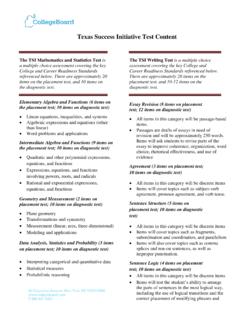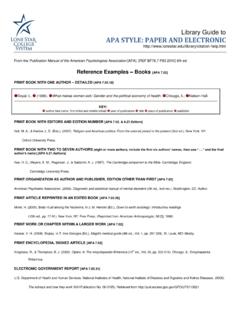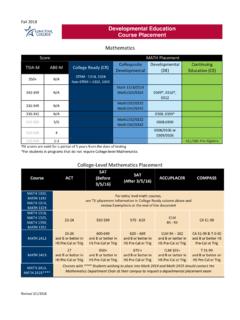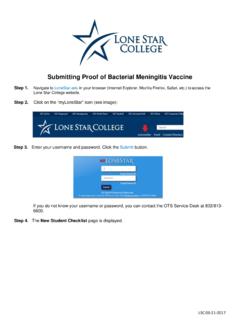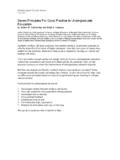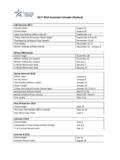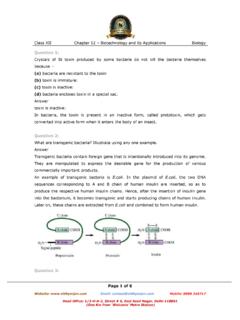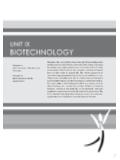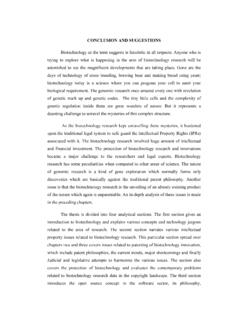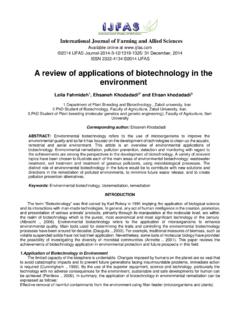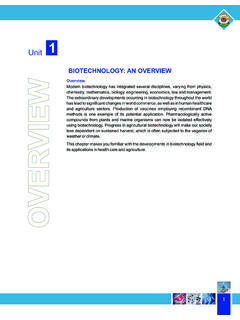Transcription of A Resource Guide for Biotechnology Club Sponsors
1 Medical Biotech Page 1 NSF Award # 0401988 MEDICAL Biotechnology A Resource Guide for Biotechnology Club Sponsors This chapter contains background information, experiment ideas and contact suggestions. Topics covered include: Human Gene Project Detecting Genetic Diseases Pharmacogenomics Gene Therapy Arrays Medical Biotech Page 2 Medical Biotechnology Medical Biotechnology is an application of Biotechnology that touches the lives of individuals every day.
2 Both wellness and illness have ties to Biotechnology . Advances in biology over the last 20 years have generated new insights into the causes of disease. This new level of understanding has, in turn, created opportunities for the development of new therapies, drugs, diagnostic tools and research/clinical instrumentation. Medical Biotechnology is one of the fastest growing opportunities for employment in the medical research field. Scientists are looking at the genetic causes of diseases, genetic links among family members, and individualized cures. As the Human Genome Project continues to map the locations of genes on human chromosomes, more solutions to the cause, prevention and cure of diseases will be discovered.
3 Students will enjoy many aspects of medical Biotechnology as they study genetic diseases and relate them to the medical experiences of family and friends. Some of the topics related to medical Biotechnology have been covered in other chapters. This chapter will offer background information and activities in the following areas: Human Genome Project and its influence on medical Biotechnology Detecting Genetic Diseases Biotech in the Hospital o Pharmacogenomics o Gene therapy o Arrays Medical Biotech Page 3 Human Gene Project and its Influence on Medical Biotechnology The human genome project was begun in 1990 and was coordinated by the Department of Energy and the National Institutes of Health.
4 The project was projected to last 15 years, but rapid technological advances facilitated completion in 2003. Some of the project s goals were to: identify all the approximately 20,000-25,000 genes in human DNA, determine the sequences of the 3 billion chemical base pairs that make up human DNA transfer related technologies to the private sector address the ethical, legal, and social issues (ELSI) that may arise from the project A genome is all the DNA in an organism, including all of its genes. Genes carry information for making all the proteins required by an organism. These proteins determine such things as the organism s appearance, how it metabolizes food and how it fights infection.
5 They can also influence an organism s behavior. DNA is made up of four similar nucleotides (designated by an organic base they contain, abbreviated A, T, C, and G) that are repeated millions or billions of times throughout a genome. The human genome, for example, has 3 billion pairs of nucleotides or base pairs. Knowledge about the effects of DNA variations among individuals can lead to revolutionary new ways to diagnose, treat, and someday prevent the thousands of disorders that affect us. Some current and potential applications of genome research include Molecular medicine Energy sources and environmental applications Risk assessment Bioarchaeology, anthropology, evolution, and human migration DNA forensics (identification)
6 Agriculture, livestock breeding, and bioprocessing Molecular Medicine Some of the goals of molecular medicine include Improved diagnosis of disease Earlier detection of genetic predispositions to disease Rational drug design Medical Biotech Page 4 Gene therapy and control systems for drugs Pharmacogenomic ("custom drugs") Increasingly detailed genome maps have aided researchers seeking genes associated with dozens of genetic conditions, including myotonic dystrophy, fragile X syndrome, neurofibromatosis types 1 and 2, inherited colon cancer, Alzheimer's disease, and familial breast cancer.
7 Doctors can identify people at high risk for conditions that may be preventable or its consequences lessened with appropriate treatment. It is projected that in the next 15 years, thousands of potential new drugs will be identified for testing as possible commercial products. Many will be manufactured by recombinant DNA technology so they will be "reagent-grade pure," just as human insulin and growth hormone are today. Individual medical records may someday include a listing of that person s complete genome as well as a catalogue of single base-pair variations that can be used to accurately predict his or her responses to certain drugs and environmental substances.
8 This will permit each person to be treated as a biochemical and genetic individual, thus making medical interventions more specific, precise, and successful. Today, many people die each year from adverse reactions to drugs, while others have uncomfortable or dangerous side effects. As genes and other DNA sequences that influence drug response are identified, it is projected that the number of toxic responses will drop and most side effects can be eliminated. Internet resources: Dolan DNA Learning Center, Cold Spring Harbor Laboratory: Great site for information, video, audio, animations, etc. Many different topics can be accessed from the same site. (Click to view web snapshot) Page 15 All About The Human Genome Project: Official site of the Human Genome Research Institute: Great information and links with audio explanations of concepts.
9 (Click to view web snapshot three pages) Pages 16-18 The Science Behind the Human Genome Project: Basic Genetics, Genome Draft Sequence, and Post-Genome Science. Basic information with many links Medical Biotech Page 5 Journey into DNA: a NOVA movie. The entire 2 hour movie can be downloaded in segments so students can explore their areas of interest. (Click to view web snapshot two pages) Page 19 Cracking the Code of Life. A complete educational module from NOVA: The site has wonderful animations and videos. Computer simulation Bacterial Identification Lab: This lab will familiarize students with the techniques used to identify different types of bacteria based on DNA sequences.
10 Steps include sample prep, PCR amplification, PCR purification, sequencing preparation, DNA sequencing, and sequence analysis. This is a very engaging and colorful simulation. (Click here for introduction screen) Page 38 Medical Biotech Page 6 Detecting Genetic Diseases Until recently, most genetic testing occurred on fetuses for the purpose of identifying the sex of a child or to detect a small number of genetic diseases (such as Down syndrome). Amniocentesis was used in these cases a needle is inserted through the mother s abdomen into the pocket of amniotic fluid surrounding the fetus.

